Introduction to Kitchen Chimney
- A kitchen chimney is a modern and essential appliance that can improve the overall look and functionality of your kitchen as presented in the post.
- It is an efficient way to keep your kitchen smoke-free and odor-free, especially if you love to cook
- With the increasing popularity of chimneys, it is essential to know the types, features, and benefits of a kitchen chimney before making a purchase
- In this blog post, we will discuss everything you need to know about kitchen chimneys.
Why is kitchen Chimeny necessary?
- The chimney is necessary for kitchens, and hotels to keep kitchens healthy
- . Many people often think that they do not require a kitchen chimney as they have an exhaust fan
- A kitchen chimney is installed right above the cooktop, and thus, it removes the cooking fumes and oil particles as soon as they are released
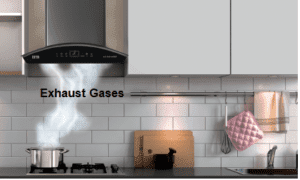
- A kitchen chimney is a type of ventilation system installed above the stove in kitchens to remove smoke, heat, steam, grease, and cooking odors from the air
- It typically consists of a hood or canopy that is mounted above the cooking surface, a fan that draws air through ducts, and a filter to trap grease and other pollutants
- Chimneys come in various sizes and designs, including wall-mounted, island-mounted, and downdraft models, and can be made of a variety of materials, such as stainless steel, glass, or ceramic
- The primary purpose of a kitchen chimney is to improve the indoor air quality in the kitchen and reduce the risk of fire.
What are the benefits of Kitchen Chimneys?
- Improved Air Quality:
- Kitchen chimneys remove smoke, grease, and oil from the kitchen, improving the air quality
- This is especially important for people with respiratory problems, as smoke and fumes from cooking can cause irritation and allergies.
- Smoke-free Cooking:
- Cooking can produce a lot of smoke, especially when using high heat
- A kitchen chimney removes this smoke, keeping your kitchen smoke-free and pleasant to work in.
- Reduced Kitchen Odor:
- Cooking can produce strong odors that linger in the kitchen
- A kitchen chimney removes these odors, keeping your kitchen fresh and odor-free.
- Low Maintenance:
- Kitchen chimneys are easy to maintain, with most models requiring only regular cleaning of the filters
- This is an essential factor to consider, as a clogged chimney will not function efficiently.
- Adds Value to Your Home: A well-designed kitchen chimney can enhance

Types of Kitchen Chimneys for Clean Home
There are the following types of chimney
Wall-Mounted Chimneys
- These chimneys are mounted on the wall above the cooktop and are the most common type of kitchen chimney
- They come in various sizes and designs to match the interiors of your kitchen.
Island Chimneys
- As the name suggests, island chimneys are installed above an island cooktop, which is a popular option in modern kitchens
- They add a unique look to the kitchen and are ideal for large kitchens with ample space.
Corner Chimneys
- These chimneys are designed to fit in the corner of the kitchen, making the most of the unused space
- They are perfect for small kitchens as they save floor space.
Downdraft Chimneys
- Downdraft chimneys are installed on the cooktop itself, with the suction taking place from below
- They are an innovative and sleek option for modern kitchens.
- The shape of the kitchen chimney hood
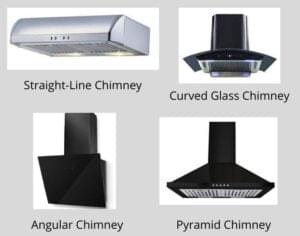
Which Chimney is better either Duct or Ductless?
- Ducted and ductless kitchen chimneys serve the same primary purpose of removing smoke, odors, and grease from your kitchen while cooking, but they achieve this goal through different mechanisms.
- Let’s explore the key differences between ducted and ductless chimneys:
Ducted Kitchen Chimney and Its Benefits:
- A ducted chimney, also known as a vented or exhaust chimney
- It is a kitchen ventilation system designed to expel smoke, odors, and grease generated during cooking directly to the outdoors.
- It works by pulling in the polluted air from the cooking area, passing it through filters to capture grease particles and impurities, and then expelling the cleaned air through a duct that leads outside the building.

- Here are the key features and benefits of a ducted chimney:
- Ventilation Efficiency:
- Ducted chimneys are generally more effective in removing smoke, odors, and grease particles from your kitchen.
- They expel the air to the outside through ducts, ensuring that pollutants don’t re-circulate back into the kitchen.
- Installation:
- Ducted chimneys require proper installation of ductwork that connects the chimney to an exterior vent.
- This installation can be more complex, especially if your kitchen layout doesn’t easily accommodate ducts.
- Suction Power:
- Ducted chimneys often have higher suction power due to the direct expulsion of air outside.
- This makes them more suitable for kitchens with heavy cooking and frequent use.
- Noise Level:
- Ducted chimneys are generally quieter because the noise of the expelled air is outside the kitchen.
- The motor noise inside the kitchen is usually lower compared to ductless chimneys.
- Maintenance:
- The maintenance of ducted chimneys is often centered around cleaning and maintaining the filters and the ductwork.
- Regular maintenance is essential to ensure optimal performance.
- Space Consideration:
- Ducted chimneys might require more space for the ductwork, and the layout of your kitchen needs to be planned around this requirement.
Ductless Kitchen Chimney:
- A ductless chimney is a type of chimney that does not require any external ducting system to expel the kitchen smoke or fumes generated during cooking.
- Instead, this company uses a wire filter to trap the smoke, fumes, and grease and releases the purified air back into the kitchen.
- This makes it an ideal solution for those living in apartments or houses where ducting systems are not feasible or cannot be installed.
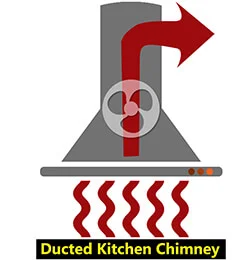
- The following are features of ductless chimney
- Installation: Ductless chimneys are easier to install since they don’t require the installation of ducts. This makes them suitable for apartments, rented homes, or spaces where duct installation is challenging.
- Recirculation: Ductless chimneys use recirculation technology, where the air is pulled through filters to remove impurities before being released back into the kitchen. This process reduces odors and grease particles.
- Filter Maintenance: Maintenance involves regular cleaning or replacement of filters to ensure effective filtration. The frequency of maintenance depends on the type of cooking you do and the quality of filters used.
- Flexibility: Ductless chimneys offer more flexibility in terms of installation location and can be used in a variety of kitchen layouts.
- Energy Efficiency: Ductless chimneys consume less energy as they don’t need to expel air outside through ducts.
- Noise Level: Ductless chimneys might be slightly noisier due to the recirculation process, but advancements in technology have reduced noise levels over time.
- Overall, the choice between a ducted and ductless kitchen chimney depends on factors like your kitchen layout, ventilation options, cooking habits, and the level of convenience you desire.
- Ducted chimneys are generally more effective but require duct installation, while ductless chimneys offer easier installation and maintenance but might be slightly less efficient in heavy cooking scenarios.

Key Features of Kitchen Chimneys
Suction Power
- The suction power of a kitchen chimney is measured in cubic meters per hour (m3/hr).
- The higher the suction power, the more efficiently it can clear the smoke and odor from the kitchen.
Filter Types:
- Kitchen chimneys come with different types of filters such as mesh filters, baffle filters, and carbon filters. Mesh filters are the most common and simplest type, while baffle filters are more efficient in trapping grease and oil. Carbon filters are best for removing odors.
Chimney Size:
- The size of the chimney is an important factor to consider, as it needs to be in proportion to the size of your kitchen and cooktop.
- If the chimney is too small, it will not be able to efficiently clear the smoke and odor, while a chimney that is too large will be a waste of space.
Noise Level Generated by Fan
- The noise level of a kitchen chimney is measured in decibels (dB). Chimneys with low noise levels are ideal for open-plan kitchens, as they will not cause disturbance while in use.
Design:
- Kitchen chimneys come in a variety of designs, from sleek and modern to traditional and rustic.
- Choose a design that complements the interiors of your kitchen.

Where Chimeny is installed?
- The kitchen chimney is installed above the stove and near the window for better air circulation.
- You should try to install a kitchen chimney near the window as mentioned in the post. You can get access to more natural light while cooking
- The window should be away from the gas stove otherwise the suction of the will be impacted more.
- A kitchen chimney with higher air suction capacity is considered to be ideal for most Indian kitchens
- The range of flue gas or air flow rate depending on the size of your kitchen: 400 m3/hr to 1000m3/hr
- The chimneys with a long hose pipe create more negative pressure to induct more air
- The bottom funnel or cone should be designed to take all gases
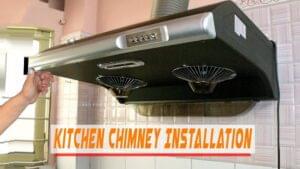
- The outlet of the chimney is kept outside the home
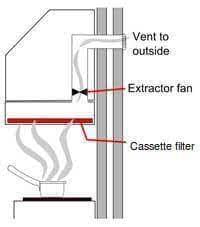
How do you select the Correct size for a kitchen Chimney?
- Selecting the correct size for a kitchen chimney involves considering various factors to ensure effective ventilation and smoke extraction.
- Here’s a step-by-step guide to help you choose the right size for your kitchen chimney:
Kitchen Size and Layout:
- Measure the size of your kitchen, including the length, width, and height.
- If you have an open kitchen connected to a dining or living area, consider the total space that needs ventilation.
- Larger kitchens may require more powerful chimneys.
Cooktop or Range Size:
- The size of your cooktop or range matters.
- If you have a larger cooktop with more burners, you’ll need a chimney with higher extraction capacity. Generally, the chimney’s width should be at least the same as or slightly larger than the cooktop’s width.
Airflow Capacity:
- The chimney’s airflow capacity is measured in cubic meters per hour (m³/h).
- A general guideline is to choose a chimney with an airflow capacity of 10-12 times the volume of your kitchen space.
- For example, if your kitchen is 15 m³, you would want a chimney with a minimum airflow capacity of 150-180 m³/h.
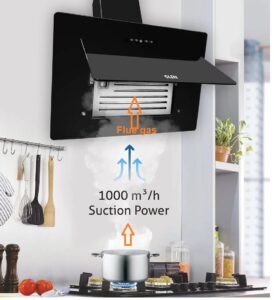
Cooking Style:
- If you cook frequently with strong spices, oils, or heavy frying, you’ll need a chimney with higher suction power to effectively remove smoke and odors.
- A chimney with a higher airflow capacity will be necessary in such cases.
Ducted vs. Ductless:
- Ducted chimneys are more effective in removing smoke and odors as they expel them outside.
- Ductless chimneys recirculate air after filtering it. Ducted chimneys generally require higher airflow capacity due to the need to push air through the ducts.
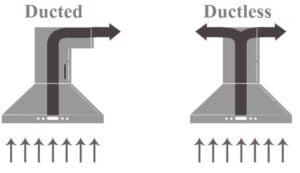
Chimney Type
- Wall-mounted chimneys are commonly used in kitchens where the cooktop is placed against a wall.
- Island chimneys are suitable if your cooktop is on an island or in the center of the kitchen.
- Choose the appropriate type based on your kitchen layout.

Noise Level:
- Consider the noise level of the chimney.
- Higher airflow capacity chimneys might generate more noise.
- Look for models with noise reduction features if noise is a concern for you.
Brand and Customer Reviews:
- Opt for reputable brands known for their quality and performance.
- Read reviews and seek recommendations from friends or family who have already purchased kitchen chimneys.

Initial and Maintenance Cost
- Your budget will also play a role in your choice.
- Higher-end chimneys might offer better features and performance, but there are also good mid-range options available.
Professional Support and Service
- If you’re unsure about the right size and type of chimney, consider consulting with a professional kitchen designer or an appliance expert.
- They can provide personalized recommendations based on your kitchen’s layout and your cooking habits.
Best Chimneys for Normal Kitchen
- The cost of a chimney varies from 150 USD (INR 8000) to 300 USD ( INR 2000).
- There is a variety of company brands and designs. Note the following points while buying a chimney
- Suction capacity should be high ( > 1000 m3/h)
- Low Noise level (< 60 DB)
- low maintenance cost
- Less Annual power consumption ( < 200 kwhrs)
- Less weight
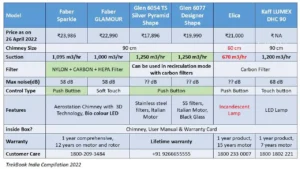
Which Chimney is the Best for an Indian Kitchen?
- Elica Filterless – Auto Clean Chimney.
- Eurodomo – Auto Clean Chimney.
- Inalsa – Pyramid Chimney.
- BLOWHOT -Baffle Filter Chimney.
- Faber Auto -Clean Kitchen Chimney.
- Hindware Auto Clean Chimney.
- Sunflame Auto Clean Chimney.
Scope of CFD simulation for Correct Size of Chimeny
- Computational Fluid Dynamics (CFD) simulation can be a valuable tool in determining the correct size and design of a chimney or ventilation system as presented in the post. It is a tool of virtual flow analysis to find the pressure drop and efficiency of the chimney.
- CFD is a powerful method for studying fluid flow, heat transfer, and other related phenomena in various engineering applications, including HVAC systems, industrial ventilation, and chimneys.
- Here’s how CFD simulation can be used for sizing and designing a chimney:
Flow Analysis:
-
- CFD simulations can model the flow of air and other gases within and around the chimney.
- This allows engineers to understand how air moves through the system, which is crucial for determining the optimal size and design of the chimney.
- CFD can help evaluate factors such as airflow patterns, velocities, and pressure differentials.
Efficiency Assessment
- : CFD simulations can assess the efficiency of the chimney system in removing smoke, fumes, or other pollutants from a specific area.
- It can help identify areas of recirculation or stagnation, which may be indicative of an inefficient design.
Stack Effect Analysis:
- In tall chimneys, the stack effect can significantly impact airflow.
- CFD can model the stack effect to determine its influence on the chimney’s performance and whether additional height is required to achieve proper ventilation.
Temperature and Heat Transfer Analysis:
- CFD can be used to model heat transfer within the chimney. This is important when dealing with high-temperature applications, such as industrial processes or fireplaces.
- Engineers can optimize the chimney’s insulation and material to handle high temperatures effectively.

Optimum Duct and Vent Design:
- CFD can assist in designing the entire ventilation system, including the ductwork and vents.
- It ensures that the entire system is balanced and properly sized to deliver efficient and uniform airflow.
- Environmental Considerations: CFD can help assess the impact of chimney emissions on the surrounding environment, making it a valuable tool for environmentally sensitive projects.
- Customization: CFD simulations can be tailored to your specific project’s needs, considering factors such as altitude, climate, humidity, and the type of pollutants being vented.
- Cost Optimization:
- By accurately modeling airflow and temperature distribution,
- CFD can help in designing cost-effective chimney systems that meet safety and performance requirements.
- Compliance and Safety:
- CFD simulations can be used to ensure that the chimney design complies with local safety and environmental regulations.
- It can help in the design of safe and compliant systems.
- Scenario Analysis: CFD simulations allow for the evaluation of multiple design scenarios and iterations without the need for physical prototypes, saving time and resources during the design phase.
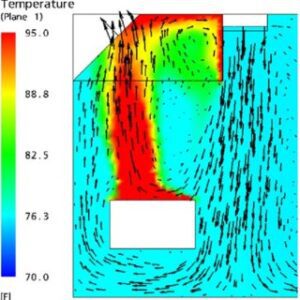
Conclusion
- The kitchen chimney helps to remove exhaust gases from the kitchen and keep clean air circulation
- There are many benefits of kitchen chimney
- It helps keep your home smoke-free by absorbing smoke and fumes.
- Removes kitchen walls oil-free with hot air
- Chimneys help recycle the air
- Reduces the amount of heat while cooking
- Adds the style quotient
- Keep recirculation of fresh air
- Remember that the goal of a kitchen chimney is not just aesthetics but also effective ventilation and odor removal.
- Choosing the right size will ensure that your kitchen remains clean, smoke-free, and comfortable while cooking
- CFD simulation is a powerful tool for optimizing the size and design of a chimney or ventilation system.
- Engineering design of a chimney using CFD simulations can help engineers and designers ensure that the chimney is efficient, safe, and compliant with regulations.
- Additionally, CFD can save costs by reducing the need for physical testing and prototypes, making it an essential part of modern engineering and design processes.


